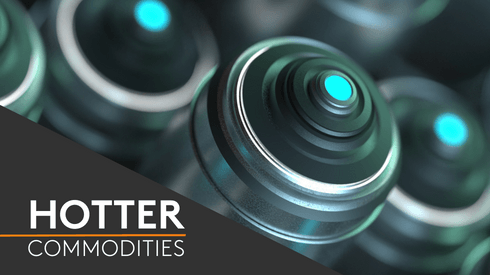The company estimates an operating cost of $444 per tonne for the project, considering both mining and processing the spodumene into concentrate form. Despite recent price declines, that still puts the deposit in a privileged economic position.
Fastmarkets’ latest price assessment for spodumene 6% Li2O, spot price, cif China was $1,150-1,200 per tonne on Tuesday June 4, down by 0.42% from $1,150-1,210 per tonne the day before and stable week on week.
According to Bandeira’s feasibility study, published on Wednesday May 29, Lithium Ionic is targeting an annual production rate of 178,000 tonnes per year of 5.5%-grade spodumene concentrate, or 24,200 tpy of lithium carbonate equivalent (LCE).
No hard date was provided in the study, given that the company is still short of licensing, but Fastmarkets understands that Lithium Ionic’s intention is to start up in the second half of 2026, potentially in July.
By then, Fastmarkets’ research team projects that the price for spodumene will have stabilized by $1,100 per tonne, and will be getting poised to rise in the following years, according to the lithium long-term forecast, published on Thursday May 30.
The forecast shows that prices would then end the decade at $2,300 per tonne, on average, in 2030 – a level that could produce 80% margins for Bandeira, if costs remain at $444 per tonne.
In the long run, the average spodumene price forecast used for the feasibility study was $2,277 per tonne for 5.5% lithium oxide content.
“This long-term price forecast was obtained by Fastmarkets,” the feasibility study read. “The conservative spodumene concentrate selling price forecast in the early years of the Bandeira mine life of $1,000-$1,600 [per tonne] for the years 2026 to 2028 resulted in an increased payback period of the project… [at] 14 months.”
Details of the study
“While we are very pleased with the results of the study, the company intends to move project engineering forward to the basic engineering phase, where a value-add process will take place to further optimize and streamline capital and operating costs,” chief executive officer Blake Hylands said in a written statement on Wednesday.
The CEO added, “Several opportunities identified in the feasibility stage will be subjected to trade-off studies, prior to entering the detailed engineering phase, to ensure the project value and operational efficiencies are maximized.”
The feasibility study takes into account the mineral resource estimate update, published on May 27, with 3.32 million tonnes in measured ore resources at a 1.38% oxide content, and 20.36 million tonnes in indicated resources at 1.33%. Inferred resources were calculated at 18.25 million tonnes at 1.37%.
Life of mine is scheduled at 14 years, reaching a post-tax net present value of $1.31 billion, or a 40% internal rate of return.
To get the go-ahead and initiate construction at Bandeira, Lithium Ionic still needs an environmental permit – one it expects to be issued around the start of the third quarter this year. The company is also still looking for additional funding.
Capital expenditures for Bandeira are estimated at $266.1 million, a sum that includes a 15% contingency of $33.7 million. Part of that investment was backed after Lithium Ionic secured a revenue royalty advancement of $20 million, in an agreement inked with Appian Capital Advisory.
Lithium Ionic executed a binding term sheet with mining-focused private equity manager Appian on Thursday, agreeing to sell a 2.25% gross revenue royalty from Bandeira in exchange for upfront cash.
Later, on Monday June 3, the company placed a private offering of units at a premium for $15 million in gross proceeds with long-term strategic shareholders. Each unit, of a total 16.7 million, will contain one common share and a purchase warrant for one half more.
According to one source with knowledge of the matter, other sources of resources could be tapped, with offtake deals among them. Investments for Bandeira to go online are not yet fully funded, they said.
“On the back of the recently announced robust feasibility study, royalty financing and other positive developments, this offering will allow us to accelerate our pathway to becoming a near-term lithium producer,” the CEO said on Monday.
Other ventures
Lithium Ionic owns projects in Brazil’s “Lithium Valley” in the southeastern state of Minas Gerais. Originally called Jequitinhonha Valley, the region was dubbed so amid several lithium deposits in different exploration or production phases, and because of how important the mineral became to power the global energy transition.
Jequitinhonha is considered one of the poorest regions in Brazil, but it is now expected to become a medium developing region in a few years, largely due to lithium. Other companies, such as Sigma Lithium – already producing spodumene there – cite this as one of the main benefits of developing those resources.
Bandeira is just one small part of the properties owned by Lithium Ionic in the region, however. More precisely, 1% of a total 14,182 hectares. Other projects include Salinas, more to the north, and Outro Lado, adjacent to Bandeira.
The company bought a 60% stake in Salinas in March 2023, which was later increased to 85%. Lithium Ionic signed a deal to acquire the remaining interest and become its sole owner on Thursday.
Payment will be made in instalments of $2 million by June 7, 2024; $1 million by April 4, 2025; and 2.5 million Lithium Ionic shares by June 18, 2024.
An initial mineral estimate report found 14.76 million tonnes in resources at the site. A preliminary economic assessment is expected in the second half of the year.
Although exploration is still ongoing and there is no official schedule out, Fastmarkets understands that it might take some three to four years before the project is ready to go operational.
Gain a competitive edge with our spodumene prices
Gain a competitive edge with our spodumene prices. Talk to us about our market-reflective spodumene prices, data and analysis.






